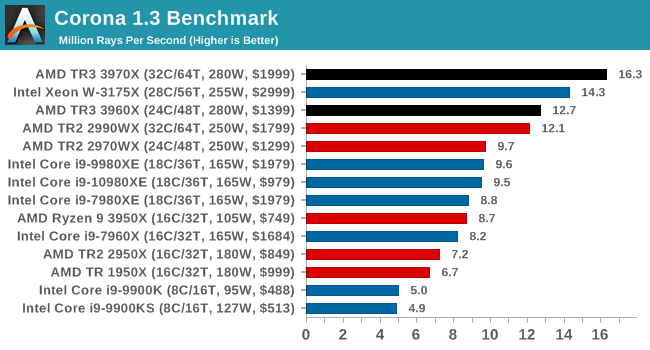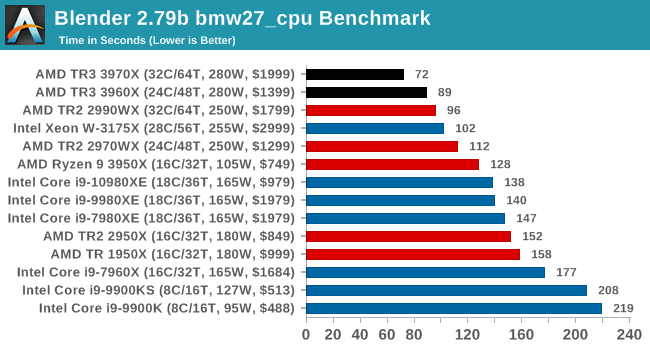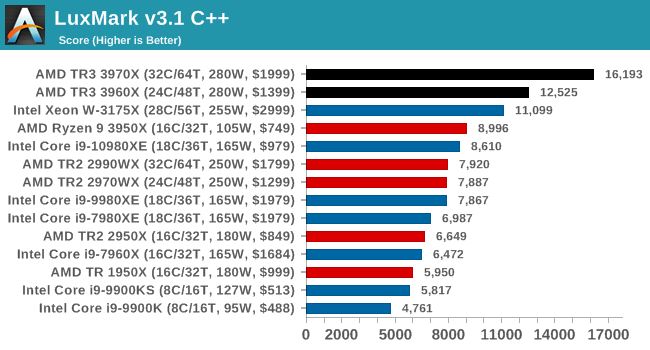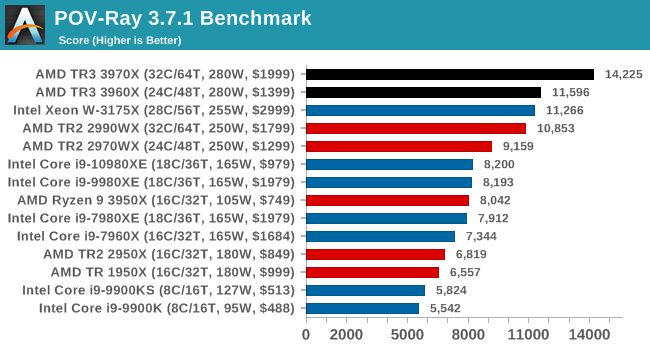The AMD Ryzen Threadripper 3960X and 3970X Review: 24 and 32 Cores on 7nm
by Dr. Ian Cutress, Andrei Frumusanu & Gavin Bonshor on November 25, 2019 9:05 AM ESTCPU Performance: Rendering Tests
Rendering is often a key target for processor workloads, lending itself to a professional environment. It comes in different formats as well, from 3D rendering through rasterization, such as games, or by ray tracing, and invokes the ability of the software to manage meshes, textures, collisions, aliasing, physics (in animations), and discarding unnecessary work. Most renderers offer CPU code paths, while a few use GPUs and select environments use FPGAs or dedicated ASICs. For big studios however, CPUs are still the hardware of choice.
All of our benchmark results can also be found in our benchmark engine, Bench.
Corona 1.3: Performance Render
An advanced performance based renderer for software such as 3ds Max and Cinema 4D, the Corona benchmark renders a generated scene as a standard under its 1.3 software version. Normally the GUI implementation of the benchmark shows the scene being built, and allows the user to upload the result as a ‘time to complete’.
We got in contact with the developer who gave us a command line version of the benchmark that does a direct output of results. Rather than reporting time, we report the average number of rays per second across six runs, as the performance scaling of a result per unit time is typically visually easier to understand.
The Corona benchmark website can be found at https://corona-renderer.com/benchmark

Being fully multithreaded, we see the order here follow core counts. That is except for the 32-core 2990WX sitting behind the 24-core 3960X, which goes to show how much extra performance is in the new TR generation.
Blender 2.79b: 3D Creation Suite
A high profile rendering tool, Blender is open-source allowing for massive amounts of configurability, and is used by a number of high-profile animation studios worldwide. The organization recently released a Blender benchmark package, a couple of weeks after we had narrowed our Blender test for our new suite, however their test can take over an hour. For our results, we run one of the sub-tests in that suite through the command line - a standard ‘bmw27’ scene in CPU only mode, and measure the time to complete the render.
Blender can be downloaded at https://www.blender.org/download/

We have new Threadripper records, with the 3970X almost getting to a minute to compute. Intel's nearest takes almost as long, but does only cost half as much. Again, the 3960X puts the 2990WX in its place.
LuxMark v3.1: LuxRender via Different Code Paths
As stated at the top, there are many different ways to process rendering data: CPU, GPU, Accelerator, and others. On top of that, there are many frameworks and APIs in which to program, depending on how the software will be used. LuxMark, a benchmark developed using the LuxRender engine, offers several different scenes and APIs.
In our test, we run the simple ‘Ball’ scene. This scene starts with a rough render and slowly improves the quality over two minutes, giving a final result in what is essentially an average ‘kilorays per second’.

Our LuxMark test again pushes both TR3 processors out in the lead.
POV-Ray 3.7.1: Ray Tracing
The Persistence of Vision ray tracing engine is another well-known benchmarking tool, which was in a state of relative hibernation until AMD released its Zen processors, to which suddenly both Intel and AMD were submitting code to the main branch of the open source project. For our test, we use the built-in benchmark for all-cores, called from the command line.
POV-Ray can be downloaded from http://www.povray.org/

More rendering, more wins for AMD. More losses for the 2990WX, even though on these tests it still beats the 10980XE quite easily.











245 Comments
View All Comments
Silma - Monday, November 25, 2019 - link
Not.Congrats to AMD on great processors, but the consumer market for $1,4-$2k processors is super tiny.
Despite the current generation of AMD processors for desktops being arguably superior to those of Intel, in the financials, Intel still destroys AMD and it is indeed a bloodbath.
In my opinion, AMD would hurt Intel much more, and in the end earn more money, if it priced its offerings lower, for consumer processors as well as datacenter processors.
sgeocla - Monday, November 25, 2019 - link
Not that small.>> Workstations are a growing market segment and have been for quite some time. They run 24-7, are extremely reliable, and have features and specifications you can’t find in a PC. Therefore, workstations can command high price points because of the high expectations users have for them. Our research shows the market size for workstations is approximately 5.3 million units, about 2% of the total PC market, and brings in over $10 billion dollars a year, almost 2.5% of the PC market total, which indicates the average selling price (ASP) is higher than the ASP of a PC.
https://gfxspeak.com/2019/05/13/stands-for-worksta...
melgross - Monday, November 25, 2019 - link
Very small. The more cores, the smaller the market. What are so many cores good for? Video editing, huge databases. Financial transactions, which the chips are not likely to be used for.For most everyone else, 8 cores is still the sweet spot.
ShowsOn - Monday, November 25, 2019 - link
The review literally discusses this point:"...Intel has reported that the workstation market has a potential $10B a year addressable market, so it is still worth pursuing. While I have no direct quotes or data, I remember being told for several generations that Intel’s best-selling HEDT processors were always the highest core count, highest performance parts that money could buy. These users wanted off-the-shelf hardware, and were willing to pay for it – they just weren’t willing to pay for enterprise features...Now that we can get better performance at $1999 with 32 cores, assuming AMD can keep stock of the hardware, it stands to reason that this market will pick up interest again."
twtech - Monday, November 25, 2019 - link
They need to partner with a workstation vendor such as Dell, HP, etc. - or pick/create a company to partner with. Big businesses like to have a reliable single vendor they can deal with for all their server and workstation hardware, including support.eek2121 - Monday, November 25, 2019 - link
They really need Dell.xrror - Tuesday, November 26, 2019 - link
Sadly Dell always seems anti-AMD - or I guess more accurately they absolutely will not do anything that could jeopardize receiving Intel's contrarevenue.eek2121 - Monday, November 25, 2019 - link
Pretty much anybody that does graphics, video, etc. has a need for these CPUs. A large portion of professional Youtubers use blender or similar applications (that scale perfectly) to render things like 3d animations and the like. On the contrary. The market for these types of CPUs is larger than the gaming market. AMD's biggest obstacle here is getting prebuilt OEM systems built with sufficient cooling. Not many folks in that audience are going to build their own PC.melgross - Monday, November 25, 2019 - link
Nope. Graphics apps don’t use all these cores. I run that stuff. Neither do apps like Photoshop. If sometimes they use most cores, the usage ore core I’d down around 20% in spurts. Fewer cores simply have higher per core usage.As I said, video rendering is about the only thing that most users will find using a lot of cores. Even multasking doesn’t use 16 or more cores efficiently.
It’s also interesting that years ago, the argument was too much power. 150 Watters was considered to be on the high side, and not in a good way. Now these cores are moving to 300 watts, and nobody is saying anything.
Jimbo Jones - Tuesday, November 26, 2019 - link
Video rendering3D rendering
3D animation where physics calculation is need (cloth, particles, etc)
Particle simulations for 3D animation / work / science
Game creation / compiling / baking
Progamming (compiling)
VFX -- after effects, etc
Gaming while rendering out any of the above at the same time
Doing more than one thing at a time (Intel users close all their apps to game, lol)
Gaming while streaming
Youtube content creation (requires video rendering and encoding)
Digital audio workstations
To name a couple ...
I actually read someone on another comment feed defending Intel by saying "CPU's aren't even important these days anyway!" -- the desperation of fanbois to grasp at straws to defend the indefensible is hilarious ... right Mel?